What did I read this week that was newly released and wasn’t X-Men?
I’m still a long way off from being caught up to all of present-day Marvel, so I have to choose my battles – reading series that are in the early stages of their Legacy numbering or have few enough issues that I can catch up all the way. A handful of indie series I follow (one only begrudgingly) also dropped this week.
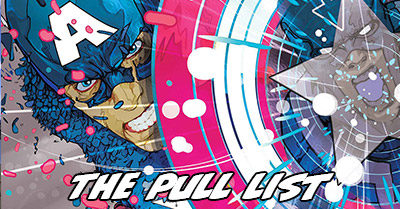
This post covers:
- Babyteeth (2017) #7
- Batman (2016) #38
- Blackbolt (2017) #9
- Captain America (2017) #697
- Crosswind (2017) #6
- Giant Days (2015) #34
- Guardians of the Galaxy (2017) #150
- Paper Girls (2015) #19
- Spider-Man (2016) #236
- Exit Stage Left: The Snagglepuss Chronicles (2018) #1
![]()
Babyteeth (2017) #7, Aftershock Comics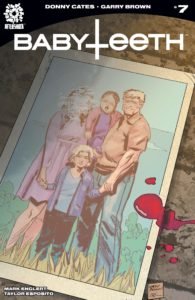
![]() I am low-key obsessed with this super bloody Donny Cates and Gary Brown team-up, which is like a bloody and demonic version of Brian K. Vaughan’s Saga. It has a lot of similar themes to Saga beyond a baby that’s a product of two different worlds – we’ve also got untrustworthy grandparents, bounty hunters, and ridiculous creatures (though the latter don’t make an appearance in this issue).
I am low-key obsessed with this super bloody Donny Cates and Gary Brown team-up, which is like a bloody and demonic version of Brian K. Vaughan’s Saga. It has a lot of similar themes to Saga beyond a baby that’s a product of two different worlds – we’ve also got untrustworthy grandparents, bounty hunters, and ridiculous creatures (though the latter don’t make an appearance in this issue).
This is a thrilling, fast-moving issue with a terrific range of artwork from Brown. I love that as the moments get tense or bloody, he tends to allow his lines to get looser, thicker, and more jagged, like we’re gradually zooming in on a quick charcoal sketch of a court reporting who is following this story from scene to scene. It’s hard to tell where Brown’s art stops and colorist Mark Englert’s colors begin, even when the page goes blood red in a violent scene. They’re a terrific art team that’s perfectly-suited to Cates’s story.
The one accusation you could sling at this issue is that it feels a bit decompressed – not because scenes unfurl slowly, but because we spend so much time away from the main plot. I couldn’t help but feel a bit cheated to spend so much time with The Silhouette when we want to see what’s happening with our main characters in an underground town in Maine. Yet, that side plot gives us valuable information about the book’s little monster and what his existence means for the world. Between that and some tantalizing revelations about the baby’s unholy grandmother, and this issue really deepens the scope of Babyteeth‘s mythology.
I’ve got a soft-spot for the slightly transgressive twists on religion that Aftershock deals in, but I think this is a great comic even without accounting for my major bias for these kinds of stories.![]()
Batman (2016) #38, DC Comics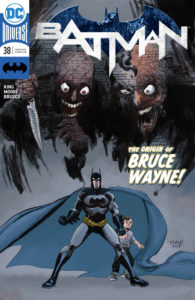
![]() It’s hard to explain the story behind this gloriously fucked up one-shot with its cover text of “The Origin of Bruce Wayne.”
It’s hard to explain the story behind this gloriously fucked up one-shot with its cover text of “The Origin of Bruce Wayne.”
Like, if there is any origin story we all know, it’s Batman’s – right?
If you’ve been keeping up with this series you know you can always expect the unexpected from writer Tom King. This is one of his masterful bottle issues, a one-shot story you can read all on its own even as it extends several ongoing threads of plot and character development.
Colorist Giulia Brusco does wonderful work here, lending a lot of texture to the world and strongly differentiating the world from scene to scene with distinct lighting effects. I noticed that penciller Travis Moore radically changes his style as we zoom in close on faces, which can lead to a few disorienting moments as we move from a cleaner-lined wide shot to a close-up with more sketched creases and wrinkles. That said, he draws a great Batman, no matter how far away from him we are.
I don’t want to ruin the story or its twist, but it’s not at all a retread of Batman’s origin. It’s an actual, honest-to-goodness mystery that requires detective work from the dark knight, and the clues are such that you’ll understand where they lead at the same time that Batman does.![]()
Black Bolt (2017) #9, Marvel Comics
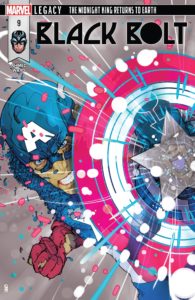
![]() This is one of the greatest covers of all time for one of the greatest single Marvel issues of all time.
This is one of the greatest covers of all time for one of the greatest single Marvel issues of all time.
Yeah, you read that right.
Writer Saladin Ahmed made a sympathetic character out of Crusher Creel, The Absorbing Man, in the first arc of this book. It sometimes felt like he was digging a little too deeply into Creel and his origins and now we see the payoff to that focus. Black Bolt feels duty-bound to visit Creel’s partner in life and crime, which leads to one of her most potent story beats of all time.
Christian Ward is illustrating on some supernatural level here, drawing and coloring like his life depends on it. He does action, psychic powers, and a sombre funeral all with eye-popping panache and just the right amount of restraint.
This book has been strong from the start, but it’s so important that Marvel like Ahmed take it back to earth so we could get the denouement of the story – and now, apparently, Black Bolt playing King of the Inhumans on earth for the first time since the Inhumans franchise began (even while his entire family is out in space).
While the visuals here are undeniably great, I don’t know the plot of this issue will pack quite the same wallop read on its own, or even with the preceding issue. You really need all of the Absorbing Man moments from the first arc to fully appreciate just how powerful this issue really ise.![]()
Captain America (2017) #697, Marvel Comics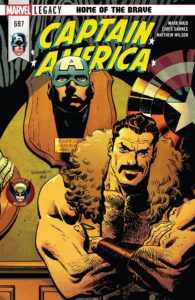
![]() Mark Waid and Chris Samnee are rebuilding the legend of Captain America issue by issue with a series of stories that emphasize his capacity for empathy and gift for strategy as powers greater than the gifts of his Super Soldier serum.
Mark Waid and Chris Samnee are rebuilding the legend of Captain America issue by issue with a series of stories that emphasize his capacity for empathy and gift for strategy as powers greater than the gifts of his Super Soldier serum.
This issue is a little less satisfying than the prior two, maybe because it features a smaller cast for Cap to interact with and ends on a cliffhanger. A plainclothes Steve Rogers falls prey to Kraven and a specially designed hunt. This feels like a bit of a cheat, as I think we’d all love to see a true Cap/Kraven issue-long showdown, but it’s something other than that.
We do get to see Cap wrestle a leopard, tho!
Anyway, the real delight of this series is as much the artwork as the plot, and Chris Samnee and Matthew Wilson continue to deliver here. Samnee continues to be a master of clearly-choreographed action, but here I was even more enamored with Wilson.
I’m already convinced he’s one of the best colorist in the business, but usually his work is big, bold, and modern. Here, his coloring on Samnee is straight-up Silver Age. Wilson’s flat, solid-color fills are streak with hints of discoloration, not only lending texture to his art but implying that we’re reading it from a ruddy old piece of newsprint.![]()
Crosswind (2017) #6, Image Comics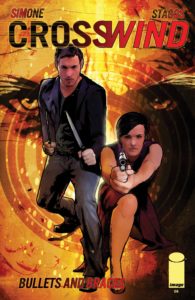
![]() The madcap violence of the finale of this Gail Simone / Cat Stagg’s body-swapping series makes for the strongest issue yet.
The madcap violence of the finale of this Gail Simone / Cat Stagg’s body-swapping series makes for the strongest issue yet.
This chapter resolves all of the open plot threads of this series, from bitter adultering husbands to bitter competing assassins. It also leaves us with an unexpected resolution to the crossed lives of a timid housewife and a control-freak assassin.
The coloring from artist Cat Staggs has finally calmed down a bit, with more vivid, painterly colors here than we’ve seen so far. Staggs’ line work has always been impressively grounded in realism, but pushing her color work into a slightly heightened-reality place makes the line work read much better than sticking with muddier “real world” colors.
On the whole, this series has been an interesting commentary on the meaning of and fluidity of gender. It almost feels like Simone is making a case for Gender Essentialism, and that once you’re into a body you just snap into its gender role. With the full series in our rearview, I think her point is something subtler – that we’re all willing to be a little more fluid than our circumstances invite or allow, and given the chance to live in someone else’s skin we might realize that.
This is is the first time I’m really craving more of Crosswind instead of shrugging at the end of an issue and saying, “it was fine.” That’s a sign of a book that will read a lot better in trade than in single issues. I hope it comes back from a second season, as Simone has hinted.![]()
Giant Days (2015) #34, Boom! Entertainment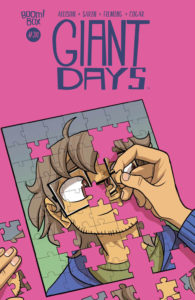
![]() I love this John Allison cartoon about how college is as much about finding yourself than finding your career. Even at its most cartoonish and comic strip moments it’s a delight.
I love this John Allison cartoon about how college is as much about finding yourself than finding your career. Even at its most cartoonish and comic strip moments it’s a delight.
This is the elucidating Ed and Esther issue we’d all been waiting for, as they trade school stories as they get progressively drunker throughout a bar crawl that’s part celebration and part commiseration.
Their drunkenness leads to some delightfully askew page layouts from Max Sarin, where it feels like the comic is leaking right off the page. It all culminates in Ed making a long-awaited confession (and maybe cracking open his skull after he is attacked by a hoard of bats).
The best part of this issue is also its weakness. I’ve been feeling for a while now that Esther has turned into both the most cartoonish and the most hilarious of the trio of women at the center of this story. That means I’m usually craving her, to the exclusion of the increasingly-shrewish Susan and the lovestruck Daisy.
While I was delighted to read a full-on Esther & Ed issue, it also subtly highlighted that imbalance for me – I’d never be so happy with an issue solely focused on any of the other characters. I know one of the themes of year three of University is going to be growing apart from your friends, but it’s going to be tricky to tell that story and keep this comic as charming as it’s been for the past few years.![]()
Guardians of the Galaxy (2017) #150, Marvel Comics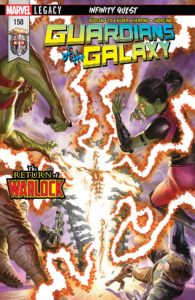
![]() This was a tremendously impressive comic book.
This was a tremendously impressive comic book.
I haven’t read Guardians for over two and a half years – since the first half of Brian Bendis’s run prior to Secret Wars – but I decided to take the plunge on this issue not realizing it was the final issue of the series.
It not only made complete sense to me with zero pre-reading, but I immediately wanted to read backward and forward from it to figure out how we got here and where we’re headed in this new Infinity Stones story Gerry Duggan has cooked up.
I loved Duggan’s feel for the big cast here, some of whom were a lot different than I recalled (Drax, especially). Artist Aaron Kuder (with colorist Ian Hering) is in the best form I’ve ever seen him on this issue.
Not only am I a lock to continue reading into Infinity Countdown, but I’m just damned impressed that Duggan, Kuder, and Hering could make the final issue of a series such an amazing jumping-on point.![]()
Paper Girls (2015) #19, Image Comics
![]() I’ll freely admit that I might just be hate-reading this series at this point for the ability to stay up on the conversations about it. The more we find out about the sprawling future war that’s causing all the dimension-hopping for our quartet of main characters, the less I care about the story – especially when it genre-hops from Land Before Time to Pacific Rim.
I’ll freely admit that I might just be hate-reading this series at this point for the ability to stay up on the conversations about it. The more we find out about the sprawling future war that’s causing all the dimension-hopping for our quartet of main characters, the less I care about the story – especially when it genre-hops from Land Before Time to Pacific Rim.![]()
Spider-Man (2016) #236, Marvel Comics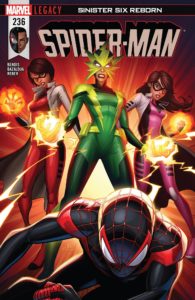
![]() Speaking of comics I am hate-reading, I’m just stubbornly hanging on to this one to see it through to the end of Brian Bendis’s run on a character who I think could be a lot more interesting than he’s been allowed to be so far.
Speaking of comics I am hate-reading, I’m just stubbornly hanging on to this one to see it through to the end of Brian Bendis’s run on a character who I think could be a lot more interesting than he’s been allowed to be so far.
Really strange rhythms in this one, as a tense nephew/uncle + daughter/mother fight is broken up by a slow-moving scene set across the country. I guess an intermission in the action is okay and created a mid-issue cliffhanger, but structurally it broke up the issue a little too much for me.
Also, it seems like Miles is way, way more skilled than his uncle based on the way the fight was illustrated – you almost got the sense he was pulling his punches a bit, which further messed up the rhythm of what I think was supposed to be a pretty tense stand-off.
![]()
Exit Stage Left: The Snagglepuss Chronicles (2018) #1, DC Comics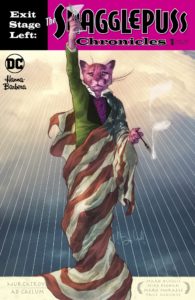
![]() A big part of the reason I love the movie CLUE other than for its farce is that the farce is situated within a particularly ominous setting. We’re in the midst of the Red Scare and McCarthyism, and these people are so terrified of being exposed for petty crimes or for just being themselves that they’ll do anything, pay anything, or murder anyone.
A big part of the reason I love the movie CLUE other than for its farce is that the farce is situated within a particularly ominous setting. We’re in the midst of the Red Scare and McCarthyism, and these people are so terrified of being exposed for petty crimes or for just being themselves that they’ll do anything, pay anything, or murder anyone.
The Snagglepuss Chronicles inhabits that same setting, adding in that anthropomorphized animals are mixed in to human society without any further comment. Parts of this script are stunning, with memorable lines that will leave you with chills. Yet, it’s not all perfect.
The story shows Snagglepuss as a descendant of the sort of room of famous writers Dorothy Parker was a part of, yet it makes you work just to understand he’s actually talking to Parker at one point. The humans in the book look quite static with faces that recall Steve Dillon, and it’s impossible tell the women apart. Linking scenes between the heavy present day dialog and historical references are dull and mechanical.
And, if you don’t know your 1950-60s US history, some of the briefer inferences in this book (hearings before Congress, Stonewall) are going to be completely lost on you.
Ultimately I think there’s a really interesting story to be here, it’s slightly obscured by the execution.